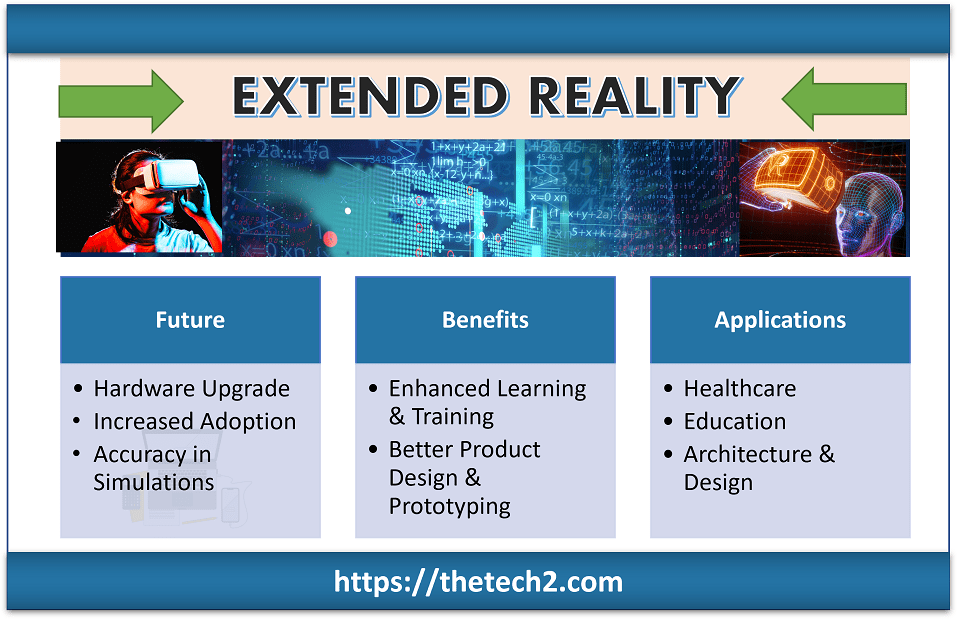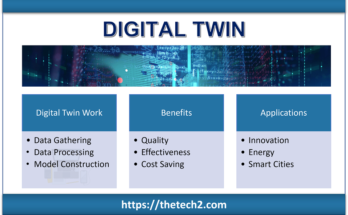Extended Reality (XR) is a technology that combines virtual and natural environments to produce a mixed-reality experience. It enables users to engage with virtual objects in a physical setting or completely submerge themselves in a digital one.

The Extended Reality technology, virtual reality (VR), creates an entirely immersive, computer-generated world that can be experienced through a headset or room-scale setup. Hand gestures or handheld controllers can be used to engage with the world, and haptic feedback, sound, and other sensory inputs can improve the user’s experience.
Another device, augmented reality (AR), superimposes digital content on the physical world. A mobile device or headset that uses a camera to record the natural world and superimpose digital content on it can be used to experience augmented reality. AR can be used for various things, including navigation, gaming, teaching, and advertising.
Digital content can be anchored to and interact with real-world items thanks to mixed reality (MR), which combines virtual and real-world environments. The user can engage with virtual objects as if they were accurate with the help of MR devices, which use sensors to map the real-world environment.
This technology has several uses in various fields, including business, gaming, healthcare, education, and amusement. For instance, Extended Reality (XR) in healthcare can be utilized for mental health treatment, patient rehabilitation, and surgical training. In business, Extended Reality (XR) can be used for virtual meetings, product creation, and marketing. Extended Reality (XR) can be used for interactive learning experiences in education.
As XR technology develops, it will likely become more widely used, less expensive, and integrated into everyday life, opening up countless opportunities for invention and artistic expression.
Applications of Extended Reality
There are numerous uses for digital extended reality (XR) technologies in a variety of industries, including Virtual Reality (VR), Augmented Reality (AR), and Mixed Reality (MR). Here are some instances of applications for digital extended reality:
Digital Extended Reality technologies for gaming provide players with fully immersive gaming experiences that take them to virtual realms. While AR technology can improve the gaming experience by superimposing digital material in the real world, VR headsets can offer complete immersion.
Education
These technologies can be used to develop interactive learning environments that let pupils practice what they have learned. For instance, while AR can be used to give pupils interactive, real-time learning experiences, VR simulations can be used to teach complex scientific concepts.
Healthcare
Extended Reality (XR) technologies can be applied in various healthcare settings, including patient rehabilitation, surgical training, and mental health treatment. While MR technology can be used for physical therapy and rehabilitation, virtual reality simulations can be used to educate surgeons.
Architecture and Design
The visualization and creation of buildings can be done using Extended Reality (XR) technologies. Architects and designers can see how their designs would appear in the real world by using augmented reality (AR) to overlay digital designs onto actual surroundings.
Marketing and Advertising
Immersive marketing and advertising experiences can be created using Extended Reality (XR) technologies. While VR can create simulated showrooms and product tours, AR can create interactive demonstrations.
Tourism and Travel
By utilizing Extended Reality (XR) technologies, people can experience virtual travel without ever departing their homes. While AR technology can provide real-time information about tourist sites, VR headsets can offer complete immersion.
These are merely a few applications of digital augmented reality technology. We anticipate seeing even more cutting-edge uses as technology advances in various industries.
Future of Extended Reality:
Hardware Upgrade
With higher-resolution displays, a wider field of vision, and improved tracking capabilities, the Extended Reality (XR) hardware is anticipated to improve significantly. This will allow new applications and result in a more immersive experience.
Increased Adoption
As the technology becomes more widely available and reasonably priced, we can anticipate an increase in the use of Extended Reality (XR) across various sectors. New possibilities for innovation and company expansion will result from this.
More Accurate Simulations
As Extended Reality (XR) technology develops, we can anticipate seeing more accurate simulations of actual settings. This will be especially helpful in medical industries where training physicians and surgeons can benefit from accurate simulations.
Integration With Other Technologies
Extended Reality (XR) will probably merge with cutting-edge technologies like 5G, AI, and machine learning. New apps like real-time translation, virtual assistants, and individualized experiences will be possible.
Collaboration and communication
Extended Reality (XR) is anticipated to revolutionize these processes. For instance, virtual gatherings have the potential to be more immersive and exciting than conventional video conferencing.
New Uses
As technology advances, we can anticipate seeing new uses for Extended Reality (XR) that we can not even currently envision. New forms of entertainment, shopping, and methods to engage with the world around us could all fall under this category.
Benefits of Extended Reality
Several advantages are provided by extended reality (XR) technologies, which include virtual reality (VR), augmented reality (AR), and mixed reality (MR).
Enhancing Learning and Training
Extended Reality (XR) can give students an immersive, interactive learning environment that allows them to exercise and learn in a secure setting.
Better Product Design and Prototyping
Extended Reality (XR) can speed up the design and prototyping process by enabling engineers and designers to see and test their designs virtually before making tangible prototypes.
Enhanced Entertainment and Gaming
Extended Reality (XR) can offer a more immersive and exciting gaming and entertainment experience, allowing users to take their engagement and immersion to new heights.
Better Healthcare and Medical Education
Extended Reality (XR) can offer medical students and healthcare workers a secure and practical setting to experiment with and learn new methods.
Output Gains
Extended Reality (XR) can help employees obtain information and carry out tasks more quickly and accurately, boosting output in sectors like manufacturing and logistics.
Enhanced Accessibility
Extended Reality (XR) can give people with disabilities new opportunities to engage in activities and settings that might not otherwise be available.
You may read our other blogs here:


